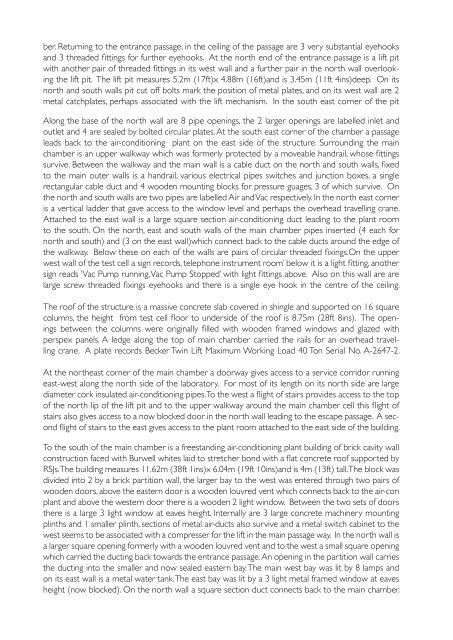Atomic Weapons Research Establishment. Orford ... - English Heritage
Atomic Weapons Research Establishment. Orford ... - English Heritage
Atomic Weapons Research Establishment. Orford ... - English Heritage
You also want an ePaper? Increase the reach of your titles
YUMPU automatically turns print PDFs into web optimized ePapers that Google loves.
er. Returning to the entrance passage, in the ceiling of the passage are 3 very substantial eyehooks<br />
and 3 threaded fittings for further eyehooks. At the north end of the entrance passage is a lift pit<br />
with another pair of threaded fittings in its west wall and a further pair in the north wall overlooking<br />
the lift pit. The lift pit measures 5.2m (17ft)x 4.88m (16ft)and is 3.45m (11ft 4ins)deep. On its<br />
north and south walls pit cut off bolts mark the position of metal plates, and on its west wall are 2<br />
metal catchplates, perhaps associated with the lift mechanism. In the south east corner of the pit<br />
Along the base of the north wall are 8 pipe openings, the 2 larger openings are labelled inlet and<br />
outlet and 4 are sealed by bolted circular plates. At the south east corner of the chamber a passage<br />
leads back to the air-conditioning plant on the east side of the structure. Surrounding the main<br />
chamber is an upper walkway which was formerly protected by a moveable handrail, whose fittings<br />
survive. Between the walkway and the main wall is a cable duct on the north and south walls, fixed<br />
to the main outer walls is a handrail, various electrical pipes switches and junction boxes, a single<br />
rectangular cable duct and 4 wooden mounting blocks for pressure guages, 3 of which survive. On<br />
the north and south walls are two pipes are labelled Air and Vac respectively. In the north east corner<br />
is a vertical ladder that gave access to the window level and perhaps the overhead travelling crane.<br />
Attached to the east wall is a large square section air-conditioning duct leading to the plant room<br />
to the south. On the north, east and south walls of the main chamber pipes inserted (4 each for<br />
north and south) and (3 on the east wall)which connect back to the cable ducts around the edge of<br />
the walkway. Below these on each of the walls are pairs of circular threaded fixings.On the upper<br />
west wall of the test cell a sign records, telephone instrument room’ below it is a light fitting, another<br />
sign reads ’Vac Pump running, Vac Pump Stopped’ with light fittings above. Also on this wall are are<br />
large screw threaded fixings eyehooks and there is a single eye hook in the centre of the ceiling.<br />
The roof of the structure is a massive concrete slab covered in shingle and supported on 16 square<br />
columns, the height from test cell floor to underside of the roof is 8.75m (28ft 8ins). The openings<br />
between the columns were originally filled with wooden framed windows and glazed with<br />
perspex panels. A ledge along the top of main chamber carried the rails for an overhead travelling<br />
crane. A plate records Becker Twin Lift Maximum Working Load 40 Ton Serial No. A-2647-2.<br />
At the northeast corner of the main chamber a doorway gives access to a service corridor running<br />
east-west along the north side of the laboratory. For most of its length on its north side are large<br />
diameter cork insulated air-conditioning pipes. To the west a flight of stairs provides access to the top<br />
of the north lip of the lift pit and to the upper walkway around the main chamber cell this flight of<br />
stairs also gives access to a now blocked door in the north wall leading to the escape passage. A second<br />
flight of stairs to the east gives access to the plant room attached to the east side of the building.<br />
To the south of the main chamber is a freestanding air-conditioning plant building of brick cavity wall<br />
construction faced with Burwell whites laid to stretcher bond with a flat concrete roof supported by<br />
RSJs. The building measures 11.62m (38ft 1ins)x 6.04m (19ft 10ins)and is 4m (13ft) tall. The block was<br />
divided into 2 by a brick partition wall, the larger bay to the west was entered through two pairs of<br />
wooden doors, above the eastern door is a wooden louvred vent which connects back to the air-con<br />
plant and above the western door there is a wooden 2 light window. Between the two sets of doors<br />
there is a large 3 light window at eaves height. Internally are 3 large concrete machinery mounting<br />
plinths and 1 smaller plinth, sections of metal air-ducts also survive and a metal switch cabinet to the<br />
west seems to be associated with a compresser for the lift in the main passage way. In the north wall is<br />
a larger square opening formerly with a wooden louvred vent and to the west a small square opening<br />
which carried the ducting back towards the entrance passage. An opening in the partition wall carries<br />
the ducting into the smaller and now sealed eastern bay. The main west bay was lit by 8 lamps and<br />
on its east wall is a metal water tank. The east bay was lit by a 3 light metal framed window at eaves<br />
height (now blocked). On the north wall a square section duct connects back to the main chamber.

















